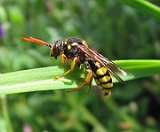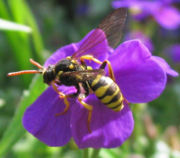
Nomada
Encyclopedia
With over 850 species, the genus Nomada is one of the largest genera in the entire family Apidae
, and the largest genus of cleptoparasitic "cuckoo bees." They occur worldwide, and utilize many different types of bees as hosts, primarily the genus Andrena
. As parasites, they lack a pollen-carrying scopa
, and are often extraordinarily wasp
-like in appearance with red, black, yellow colors prevailing, and with smoky (infuscated) wings or wing tips.
Separation of this genus (the only genus in the tribe Nomadini) from other members of the Nomadinae
can be difficult; details of the wing venation, and the nature of the patch of silvery seta
e at the tip of the female metasoma
are the best distinguishing features.

Apidae
The Apidae are a large family of bees, comprising the common honey bees, stingless bees , carpenter bees, orchid bees, cuckoo bees, bumblebees, and various other less well-known groups...
, and the largest genus of cleptoparasitic "cuckoo bees." They occur worldwide, and utilize many different types of bees as hosts, primarily the genus Andrena
Andrena
Andrena is the largest genus in the family Andrenidae, and is nearly worldwide in distribution, with the notable exceptions of Oceania and South America. With over 1,300 species, it is one of the largest of all bee genera...
. As parasites, they lack a pollen-carrying scopa
Scopa (biology)
The term scopa is used to refer to any of a number of different modifications on the body of a non-parasitic bee that form a pollen-carrying apparatus. In most bees, the scopa is simply a particularly dense mass of elongated, often branched, hairs on the hind leg...
, and are often extraordinarily wasp
Wasp
The term wasp is typically defined as any insect of the order Hymenoptera and suborder Apocrita that is neither a bee nor an ant. Almost every pest insect species has at least one wasp species that preys upon it or parasitizes it, making wasps critically important in natural control of their...
-like in appearance with red, black, yellow colors prevailing, and with smoky (infuscated) wings or wing tips.
Separation of this genus (the only genus in the tribe Nomadini) from other members of the Nomadinae
Nomadinae
The subfamily Nomadinae is the largest and most diverse group of cleptoparasitic "cuckoo bees" with 31 genera in 10 tribes; they occur worldwide, and utilize many different types of bees as hosts. As parasites, they lack a pollen-carrying scopa, and are often extraordinarily wasp-like in appearance...
can be difficult; details of the wing venation, and the nature of the patch of silvery seta
Seta
Seta is a biological term derived from the Latin word for "bristle". It refers to a number of different bristle- or hair-like structures on living organisms.-Animal setae:In zoology, most "setae" occur in invertebrates....
e at the tip of the female metasoma
Metasoma
The metasoma is the posterior part of the body, or tagma, of arthropods whose body is composed of three parts, the other two being the prosoma and the mesosoma. In insects, it contains most of the digestive tract, respiratory system, and circulatory system, and the apical segments are typically...
are the best distinguishing features.

External links
- Image Gallery
- http://www.bugguide.net (Search for Nomada, North American species only).

